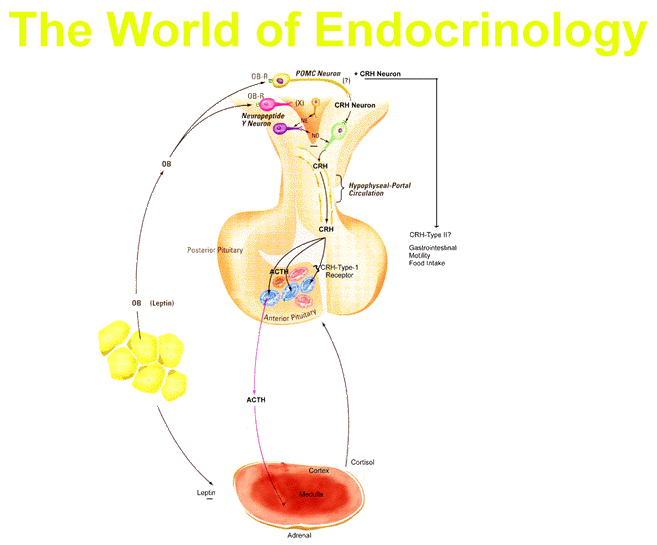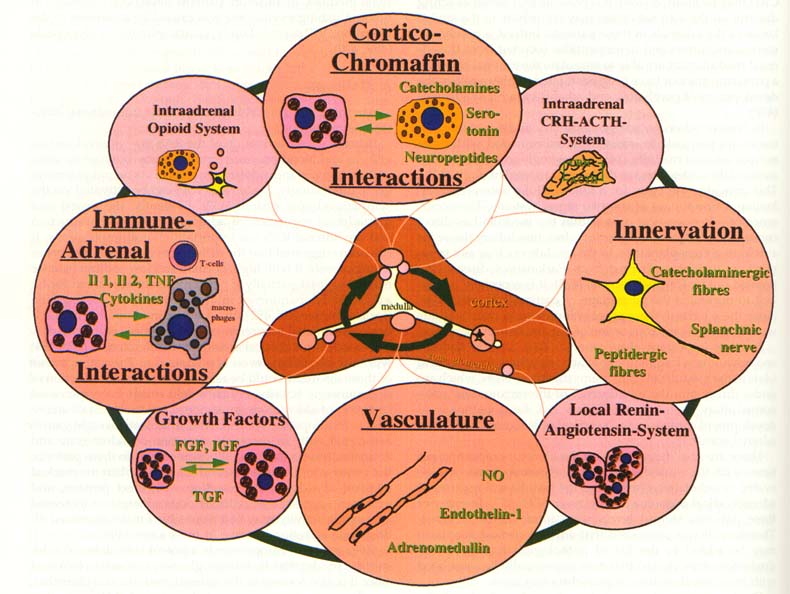
Basic Research
Intraadrenal Interactions in the Regulation of Adrenocortical Steroidogenesis Monika Ehrhart-Bornstein, Joy P. Hinson, Stefan R. Bornstein, Werner A. Scherbaum, and Gavin P. Vinson. Endocr Rev. 1998 Apr; 19(2): 101-143. Abstract |

Techniques Transfection of Endocrine Cells Quantitative PCR Quantitative PCR Qualitative investigation of ribonucleic acid
expression gives insights in the regulation of biochemical processes. However, qualitative
measurements alone often remain unsatisfactory when an alteration of expression from a
basal rate, say, that of an enzyme, becomes cruical in reaching a new quality. Therefore,
a quantitative determination of ribonucleic acid copies per cell is more and more desired.
Real time PCR of reverse transcripts offers the opportunity to easily overcome the
classical problems of quantification in comparence to external standarts. In this modern
PCR technique a third primer is introduced, which through deposition of a linked
flouroescent molecule during the process of PCR, allows quantification via colorimetric
measurements. In addition, this method becomes valuable especially when determination must
be performed from low quantities of RNA and "classical" methods such as Northern
blotting fail. Laser Capture Microdissection Microdissection of human adrenal glands Ribonucleic acid (RNA)
obtained from laser capture microdissection of malignant and nonmalignant human adrenals
may serve as an indicator for the regulation of gene transcription of certain proteins.
Differences in first quality and, secondly, quantity of messanger RNA composition will be
investigated using a semiquantitative way. After being established, the above described
method of a real time PCR can also be applied to this particular project. This combined
approach will be powerful in screening a high number of tumors for any important marker
discovered. This project should provide new insights in adrenocortical tumor development. Northern Blot Analysis In this project we study bovine adrenal cytochrom P450 enzyme regulation and kinetics by analyzing substrate-induced optical difference spectrums as a measure of spin state transition due to direct ligand-protein interaction. In contrast to most other investigations in this field, we determine enzyme activity in intact cells and not in mitochondrial or microsomal membrane fractions. Current topics are the effects of leptin on CYP11A, CYP11B, CYP17 and CYP21A activity and the regulation of proteolytic degradation of this enzymes in vitro.
Transgenic Animals Metabolic function and the sympathoadrenal system are closely linked. Glucose and fat metabolism as well as thermogenisis are regulated by the sympethatic nervous system. Leptin serves as an important mediator in many of those regulatory mechanisms. However, the interaction between leptin and the sympathoadrenal system is not clearly understood. Therefore, in this project we systematically investigate the effect of catecholamine metabolism on leptin production and the metabolism in vivo. For this, we developed a transgenic mouse model overexpressing the enzyme PNMT resulting in elevated levels of epinephrine. In these mice leptin secretion and metabolic parameters of glucose and fat metabolism will be analyzed. Fat tissue will also be investigated morphologically. In addition, these data will be compared to leptin levels in pheochromocytoma patients and patients with cardiac failure. These studies are aimed to contribute to the understanding of the interaction between the sympathetic system, leptin and metabolism under physiological conditions and in states of catecholamine hypersecretion.
Immunology Normal adrenal glands express MHC class II molecules within the androgen producing Zona reticularis. Beside the balanced expression in normal adrenal glands, two altered expression patterns exist in medical conditions. A distinctive feature of adrenocortical neoplasms consists in the complete loss of MHC class II expression, as we could show in recent work. In addition, our studies on apoptosis in normal and neoplastic adrenals reveal a diminished apoptotic rate in such adrenal tumors. Contrary, in Addison's disease a high MHC class II expression has been reported, and the involution of the gland with decreasing hormonal capacity is well known. The adrenal MHC class II molecules provide one prerequisite to intercellular communication with immunocompetent cells, namely the T-Helper cells. Hence, a regulatory circuit between adrenocortical cells and T-Helper cells may guarantee cell and tissue homeostasis in both adrenocortical zones and lymphocytes. The physiologic action of this circuit could protect from both neoplastic degeneration and the danger of excessive involution in adrenals. In lymphocytes a blunting of autoreactive cells might be possible. Cell Culture In adipose people who are suffering from Non Insulin Depending Diabetes Mellitus (NIDDM) caused by insulinresistance high levels of the adipostatic hormone leptin and cortisol are found. Leptin is snythesized and produced by the adipose tissue and belived to regulate food intake. We are currently investigating the possible relationship between leptin and the cortisol producing adrenal gland. We established primary cultures of bovine adrenocortical cells to test the influence of leptin on cortisol secretion and the cortisol producing enzymes. A diabetic mouse model, in which the phenotypic symtomes are similar to human NIDDM, allows us to test the effect of leptin on cortisol production in vivo. Currently ongoing techniques for our experiments are tissue cultures, ELISA, PCR and Northern Blotting.
|